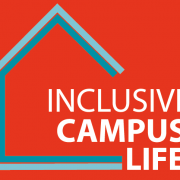The Big Read
Excerpt
The Big Read is a project that aims to make those coming to university feel welcome before they arrive, and create links between them and the staff and senior students.
When first arriving, each new student (undergraduate and postgraduate) will receive a free copy of that year's special edition Kingston University Big Read title. Current/senior students and staff will be invited to help themselves to a free copy from one of the many locations across each of the university's five campuses. These copies will be available by the end of June, so students can take them with wherever they go for the holidays and show it to family and friends.
The scheme is based on similar projects in the US that have shown that creating a community through shared reading before students arrive helps them feel welcome and settle in quickly, as well as adjust to their new life as a student. Whereas a few universities in the UK have experimented with reading schemes linked to specific types of books (e.g. prize winners) within particular faculties, Kingston is the first UK university to establish a scheme on such a wide scale, where the full university as well as the local community is involved.
This particular project is aimed to use shared reading to:
- bridge any divides between those coming to Kingston from different backgrounds and walks of life;
- enhance a sense of community among new students;
- connect the five Kingston University faculties—administrative and academic staff—with students and with each other;
- promote reading for pleasure, but to do this through a scheme appealing to all, without making any group feel particularly targeted or stigmatized.
The project has now been established both as a research project and as a key element of Kingston University’s outreach and retention programme.
Narrative, origins and objectives of the initiative
What kind of project is this? Please give a short description (summary) of it.
A widening participation initiative aimed to increase the retention rate during the students’ first semester, creating a sense of belonging through a pre-arrival shared-reading experience. The program involves all new students (undergraduate and postgraduate) and both academic and administrative staff at the university.
Please tell us why, in general, this project is considered a successful one?
In a questionnaire carried out after the first Big Read, 86% of students and 74% of staff found the initiative helpful for new students at Kingston University.
Benefits included the advance welcome offered to students, and their experience of feeling part of the university before they arrived. The scheme was perceived as an ice-breaker, creating an opportunity to bring people together, particular those with similar interests, and hence to reduce alienation. The scheme was seen as helping to prepare potential students for university, a scheme that was stimulating and made people think; one that increased the understanding of university. It offered the opportunity to read British writing and to learn more about Britain.
And why would you consider it a grass-roots initiative?
It was an initiative from a researcher at Kingston University London with a student-study research project into the leisure and reading habits of the university’s first year undergraduates, and the role ‘pre-arrival shared-reading’ could play in augmenting the welcome they experienced.
The project was undertaken as part of SADRAS (Student Academic Development Research Associate Scheme), a Kingston University scheme that is funded through the university’s Access Working Group. Collaboratively managed by the Kingston University Students Union (KUSU) and the Centre for Higher Education Research and Practice (CHERP), this project is also the first step in a wider effort to build a partnership that ensures that students and staff are equal, engaged partners in an academic community that drives forward learning, teaching, research, and innovation.
What challenges needed to be solved in this project?
- The timing of making books available to academics must be carefully considered
- It is important to include all students
- Consideration needs to be given to the inclusion of international students
- A more inclusive method of choosing the book is required
- Books need to be sent promptly to students who accept a place through clearing
Is this initiative based on any particular theoretical framework? Which one?
Firstly, there is significant evidence of the benefits of reading for pleasure, which is associated with a range of life-positives such as greater safety, health, income, professional success, articulateness, empathy, and happiness. This has been consistently reported, most recently in an extensive study undertaken by the Reading Agency and BOP Consulting (2015).
Secondly, there is literature relating to the development of shared reading schemes in US universities and to particular parts of the process. There is a common thread in such schemes that students are reported to be more likely to enroll, to feel engaged early, to be less likely to drop out, and to feel more connected locally.
There is some analysis of the outcomes of pre-arrival shared reading; for example, Ferguson (2006) and Golden (2012) both discuss the role such schemes can play in widening participation and promoting engagement. Twiton (2007) inferred a successful outcome from the qualitative comments of those who did provide feedback, the numbers of those who attended related events, and the anecdotal feedback from those involved. It was anticipated that taking part in pre-arrival shared reading would tend to confirm students’ decision to enroll and turn up. However, much of the reporting back on the outcomes of pre-arrival shared reading in universities (see the list of websites below) is general and used as promotional information rather than being subjected to academic scrutiny. This project therefore sought to re-address this gap in the literature and to analyse responses and identify outcomes among students and staff as the first stage of a longer-term research project with wider possibilities for collaboration.
(Appendix) Is your intervention standing on its own or is it a part of a bigger and more holistic approach?
Kingston University is a WP institution with a clear strategy for equality, diversity and inclusion, the latest one here https://d68b3152cf5d08c2f050-97c828cc9502c69ac5af7576c62d48d6.ssl.cf3.rackcdn.com/documents/aboutkingstonuniversity/equality-diversity-and-inclusion/documents/2016-2020_EDI%20strategy.pdf. The Big Read fits well into the strategy goals.
Please describe the group(s) intended as beneficiaries of this initiative
Why has this group (have these groups) been chosen?
The first term of undergraduate studies is the most critical one when it comes to retention. Making students feel that they belong and are a part of the university at an early stage—before they are even there—is one way to address the problem of early drop-out.
Could you please tell us something about the relative size of the (of each) target group, within the school/university population, region and/or country?
Around 10,000 annually: students and staff.
Which social characteristics are taken into account and what is the geographical area covered?
Social characteristics: For example, first generation students, second language students, international students, adult students.
Geographical area: Kingston, London—and the rest of the UK and the world, where the students are recruited.
On which level is the project implemented?
On institutional level; it is firmly integrated within the university's policies on widening participation, welcoming and ensuring the engagement of those who attend and reducing drop-out.
Please describe the political and socio-economic factors that you believe have been important enablers for your initiative
Did the initiative have political support?
The project has not so far sought direct political support. It was highlighted by CILIP's National Working party on Libraries, and hence appeared in relevant government minutes.
However, the project has attracted widespread comment within the higher education press and within bodies supporting/lobbying for higher education (e.g. the Universities Alliance; Higher Education Policy Initiative, both of whom have blogged about it) and it won The Times Higher Education's 'Outreach of the Year' Award in 2007.
How did it fit with local, regional or national policies?
There is a very strong fit with the Department for Education and Skills' emphasis on literacy and the promotion and development of an effective skill set of graduates.
Who are the stakeholders supporting the initiative?
Within Kingston University it is split between delivery (within the Directorate for Student Achievement) and associated research (within the Kingston School of Art). The Kingston University Big Read is working with four other universities to roll out pre-arrival shared reading and see how it impacts on the associated student populations.
Are there particular demographic changes present that are influencing the project?
The issue of literacy and how to address this core life-skill are debated on an ongoing basis, as are the issues of widening participation and inclusion.
What is the institutional strategy and culture of the (educational) organization?
Kingston University is a WP institution with a clear strategy for equality, diversity and inclusion, the latest one here https://d68b3152cf5d08c2f050-97c828cc9502c69ac5af7576c62d48d6.ssl.cf3.rackcdn.com/documents/aboutkingstonuniversity/equality-diversity-and-inclusion/documents/2016-2020_EDI%20strategy.pdf
To what extent does the initiative have an influence on institutional policy (or potential influence) of the (educational) organization?
It is firmly integrated within the university's policies on widening participation, welcoming and ensuring the engagement of those who attend and reducing drop-out.
(Appendix) Is there public support for your initiative and the issue it addresses?
Very wide public support. The project has built connections with local charities supporting the homeless and mental health, and had wholeheartedly positive responses from local communities, wherever the project has been developed, including within schools with whom the Kingston University Big Read has worked on developments of the project.
(Appendix) What other factors do you think have been important for the success of this initiative?
Continuity and engagement in programme management; Institutional support and budget.
Please describe the overall initiative design and the methods and tools used to reach the goals
Please describe the specific activities carried out.
Choosing the book title (developed method second time the project was run):
- Finalize a long list of books comprising all the books suggested by staff and students.
- Determine the key criteria for a suitable KUBR book against which each of the books should be assessed.
- Determine a scoring system for each of the criteria and assign weightings to each criterion.
- Score each book against each of the criteria to produce a weighted total score for the book. Produce a ranked list of all the books based on this scoring. Test the sensitivity of the ranking to various weighting systems.
- Pick the shortlist—the top six books on the list—to be read by the panel. Approach the publishers and, provided the publishers’ responses are encouraging, ask the panel members to read each of the books on the shortlist. Hold panel meetings to select the final book.
The book was sent to all first year students as a pre-arrival shared reading book. During Welcome Week, the book was discussed during a variety of activities, for example the author visiting the university, a so-called balloon debate, short (50 minutes) sessions about the book on every campus, offering the opportunity for students to talk both about the book and about the experience of pre-arrival shared reading.
Many teachers used the book in their teaching, for example in Health Education to address difficult topics, such as suicide or discussing mental health, but also in more general academic areas, such as the academic writing process.
What were the key roles (teacher, student, management team etc.) within the project?
The project manager/management team plays a key role. However, the engagement from students and staff is of course also very important.
What ideas, tools, theories, models, methodology (etc.) have been used to reach the goals?
The idea of the practice of ‘common reading’; physical books; theories shared above under 'theoretical framework'; model for choosing a title shared under 'specific activities carried out'.
What are the final revenues of the project?
Please describe if your project ensured its sustainability
If so, how did you ensure the short-term impact of the project?
And how did you ensure the long-term impact of the project?
Has your project been replicated elsewhere?
Edinburgh Napier University in 2016; University of Wolverhampton in 2017
Community Services, which helps people experiencing temporary homelessness, worked with the Big Read to establish shared reading sessions. These have now developed into shared writing sessions, with the establishment of a library as a permanent feature of the common space and a change to guests' access hours if they are devoting time to reading.
The Big Read has also worked with Coombe Boys' Senior School to study the impact of sharing a book in easing the transition between junior and secondary school. This has revealed a significant change in both pupil and staff behaviour that correlates with the introduction of shared reading. In collaboration with the local library authority, a series of 'best practice' seminars have been developed between academic and borough librarians.
Please tell us about the resources used in this initiative
What was the budget for the initiative?
How much did the initiative depend on volunteers?
The project depended on student involvement, but they were paid for this as part of a student-staff research system called SADRAS. For rolling out into the wider community the project had involvement from various professionals (librarians, mental health and homeless charities) but they have been paid by their respective agencies. Within individual associations, e.g. University of the Third Age, who the project invited to the author event, the project has benefited through volunteers spreading our message.
How were the costs perceived by the public/the sector/other stakeholders?
Very positively. The book compares very well with other promotional items but feels much more meaningful for HE. It's also very relevant—in the UK universities talk about students coming there to 'read' for a degree, and librarians at KUL say that the books were never found in waste-bins or being used as coffee mats. The university even had to organise a reprint to meet demand several times.
To what extent did the initiative achieve its objectives?
Please describe the evidence to support the success of your initiative.
(Also shared under “Why this project is considered a successful one”)
In a questionnaire carried out after the first Big Read, 86% of students and 74% of staff thought the initiative helpful for new students at Kingston University.
Benefits included the advance welcome offered to students, and their experience of feeling part of the university before they arrived. The scheme was perceived as an ice-breaker, creating an opportunity to bring people together, especially those with similar interests, and hence to reduce alienation. The scheme was seen as helping to prepare potential students for university, a scheme that was stimulating and made people think, and that increased understanding of university. It offered the opportunity to read British writing and to learn more about Britain.
Did the intervention lead to any unintended (positive) outcomes?
Yes. The main unexpected finding was how much universities’ administrative and professional staff enjoyed the initiative. Perhaps HE has a tendency to marginalise the involvement of the wide range of colleagues involved in the student experience. These colleagues are routinely referred to as 'non-academic', thus itemising them by what they don't do rather than their role as professional, administrative or support staff. The project has offered colleagues across the university new ways of connecting—and both staff and students have reported back (through questionnaires) that they discussed both the book and the project with many different individuals.
Secondly, to find the extent of the pre-arrival shared-reading going on in the US (700+) institutions, but that it is almost entirely not analysed. KUL is breaking ground by seeking to monitor and evaluate their progress, and their findings have been of strong interest to the US.
What indicators (quantitative and qualitative) have you measured to demonstrate success?
Informal
Initial response to the physical object bearing the university branding
The initial response from staff
Heavy demand for copies of the book
Attendance at related events
Formal
Survey of staff and student reactions to the Big Read
From the responses received from students and staff taking part of the first Big Read project, five key findings from the survey are summarized, considering:
- Attitudes towards reading are positive: staff and students like reading for pleasure
- Distribution of the titles was mostly successful
- The book was widely read and discussed, and the events were well attended
- The book was mostly considered a good choice, especially by the students
- There was strong support for the initiative as a whole; students were particularly positive
(Appendix) How did you evaluate/monitor this intervention?
Paper reporting and reflecting on the processes and outcomes of the programme:
- Baverstock, A., Steinitz, J., and Bryars, L., 2017. ‘What Was the Process and Response of University Staff and Students to the Availability of a Shared Reading Scheme for Those Embarking on a University Education? A case study’, Logos, 28 (1), pp. 29–44.
Paper considering action research into how best to choose a common book:
- Baverstock, A., Steinitz, J. et al. ‘How Do You Choose a Book for a Pre-arrival Shared Reading Scheme in a University?’ Logos, 23 (3), pp. 41–57.


 Caritas Wien/Stefanie Starz
Caritas Wien/Stefanie Starz

 Sale für Alle 2018
Sale für Alle 2018

